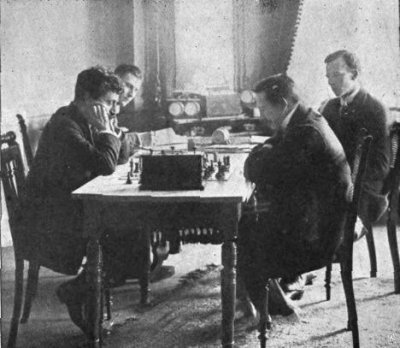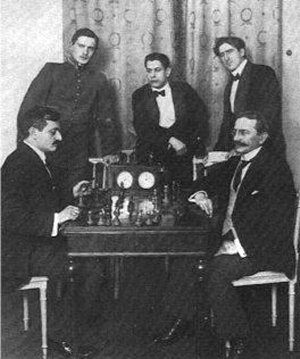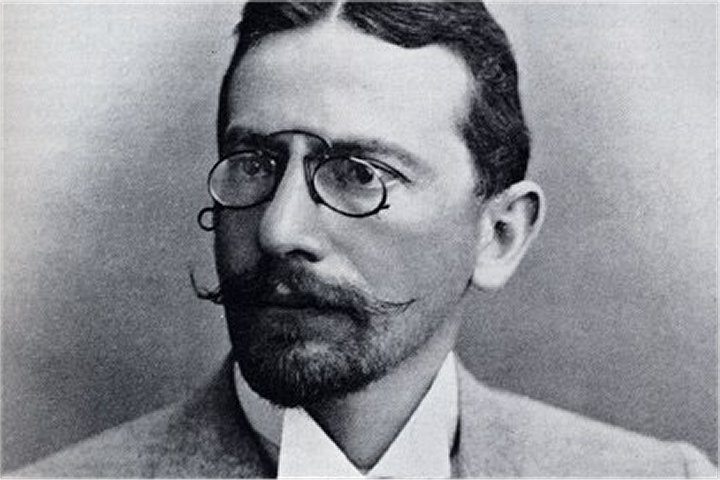It’s the World Chess Championship of 1908. The defending champion is the great Emanuel Lasker, now defending his crown for the third time.
The chess world is abuzz with excitement, as everyone is certain Lasker has finally met his match. He has gone from strength to strength since snatching the title from Wilhelm Steinitz, demolishing Steinitz in their return match 10-2, and Frank Marshall 8-0 in his first two title defenses.
This time, however, he is facing Siegbert Tarrasch, and even Lasker himself can scarce imagine a lopsided result. Tarrasch earned his title shot by winning Ostende 1907, but he has been a formidable force since the late 1880s. He, not Lasker, was once considered the logical successor of Steinitz, and he had waited long for this this chance to fulfill that promise.
Arranging the match had been long and arduous, for while Lasker and Tarrasch are both Germans, they cannot brook their differences. A similar attempt to bring them to the table in 1903 had all failed. Now, as the match is finally about to unfold, the organizers have called them to bury the hatchet. Even a world championship match, after all, is only a sporting event. Tarrasch has been said to click his heels and quip before leaving promptly: "To you, Herr Lasker, I have just three words to say: check and mate.”
This story about Tarrasch reflects much of what we know about him today. He was an incredibly strong player who was ripe for the world championship for close to two decades. He, too, was a man of ideas, one of the most influential, in fact, in the long history of chess. He stood obstinately for what truths he saw on the board, and made no compromises about them that he has been branded "dogmatic." He was a contentious and difficult fellow to befriend.
March 5 this year is Tarrasch’s 160th birth anniversary, and it’s a fitting occasion to remember the man with one of the most lasting legacies in chess.
Tarrasch was born in Breslau, in what is now Poland. He studied medicine in Berlin and Halle, then left for Nuremberg, Bavaria, and finally Munich to establish his medical practice.
He stepped onto the tournament scene in the 1870s, and quickly proved himself a world-class player. At the end of the 1880s, he began an impressive six-year stretch that saw him winning five major international events successively: Nuremberg 1888, Breslau 1889, Manchester 1890, Desden 1892, and Leipzig 1894.
In 1892, he was offered a world title match in Havana, but declined because of the demands of his medical profession. Tarrasch may have been wary of risking all his gains in one swing of the world championship, but he wasted his opportunity. At a time when he was nearing his absolute peak and Steinitz was an aging champion, his chances for success were considerably great. Lasker, on the other hand, didn’t let his chance pass him by, and it was he who dethroned Steinitz in 1894.
All roads, thereafter, would lead to the match against Lasker. Tarrasch placed a strong fourth in Hastings 1895, and third in Nuremberg 1896. He won Vienna 1898, capping the decade with what was perhaps the greatest performance of his career.
At the turn of the new century, he won Monte Carlo 1903, thrashed Frank Marshall, the 1907 world title challenger, 8-1 in 1905, and won Ostend 1907. In Ostend he was declared "The World Champion Tournament Player,”
Tarrasch’s title must have whetted Lasker’s competitive appetite, for their match was soon set. All the buzz and anticipation, however, were quickly dashed away as Lasker convincingly beat Tarrasch 8-3. Lasker had grown too strong, even for someone like Tarrasch.

The Championship Match Lasker (left) vs Tarrasch (right), 1908 | Photographer unknown | L. Hoffer, ed. (1908), The Championship Match: Lasker v. Tarrasch, London: E.A. Michell & Frank Hollings | Source: Wikipedia
Tarrasch would remain one of the world’s leading players despite this loss, and his last meaningful result was a strong fourth in St. Petersburg 1914. His famous victory in the 19th round against future world champion Jose Raul Capablanca helped Lasker nick Capablanca in a mad dash to the tape of this historic event. Tarrasch’s international performances would taper off soon after.

The finalists from St. Petersburg (from left to right): E. Lasker, A. Alekhine, J.R. Capablanca, F. Marshall, S. Tarrasch | Source: Wikipedia
Tarrasch played for close to fifty years, and his career was more than just a display of his powerful performances in the 1890s when he was generally regarded as the world’s best player. He also left behind his ideas and system of play in his writings and great books in Dreihundert Schachpartien (Three Hundred Games of Chess) and Die Moderne Schachpartie (The Modern Game of Chess).
Appearing as he did at the tail end of Steinitz’s career, Steinitz’s classical teachings struck Tarrasch that he became their greatest exponent. His games clearly illustrate the positional play Steinitz taught based on the elements of speedy development, space, king safety, pawn structure, piece activity, outposts, and the advantage of the two bishops. His best ones combine skillful positional maneuvering with beautiful, finishing combinations.
His style naturally evolved to be very structured and methodical. Despising cramped positions, he gave high importance to space. They carry "the germs of defeat,” he said. White, he thought, ought always to win by constriction, while Black ought to work for breaking moves that free his game and activate his pieces.
Out of these ideas, he devised two important opening systems that now bear his name, namely the Tarrasch Variations of the French Defense and the Queen’s Gambit Declined. These openings are still very popular today, even at the highest levels. The Tarrasch Queen’s Gambit Declined, especially, was tested thoroughly in the 1969 World Championship match between Boris Spassky and Tigran Petrosian.
Given Tarrasch’s self-assurance, one could imagine his clash with Aron Nimzowitsch when the Rigan revolutionized the chess scene with Hypermodernism. As Reuben Fine said, he could only lament that Homer was long gone to sing the great battle between these illustrious masters. Perhaps there wasn’t much issue after all, because it is now settled that Hypermodernism didn’t upturn the classical principles, only refine them.
Tarrasch brought to light the teachings of Steinitz, and a whole new, succeeding generation understood and assimilated them. He was called "Praeceptor Germaniae” (The Lawgiver of Germany) for this. In time, the classical, positional style was perfected by Capablanca and Akiba Rubinstein.
True, if Tarrasch weren’t around, some other great master might have played his part. As it was, he came at the perfect time, and our chess heritage is now all the richer.
Games
Here is a fine win that illustrates Tarrasch’s ability to combine positional and tactical play. The opponent is no less than a future world title contender in Isidor Gunberg.
A win against a titan of the day that helped Tarrasch capture Vienna 1898, one of the greatest victories of his career. It’s another positional game that Tarrasch finishes off with tactical flourish.
A classic game between two ideological rivals in the great St. Petersburg 1914. Here goes the double bishop sacrifice!
Links
More about Tarrasch...

























